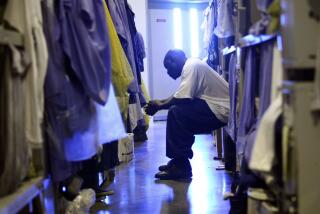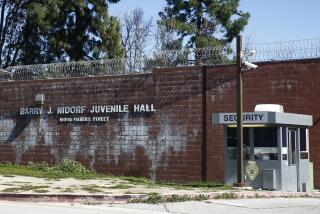Finding money in California’s prisons
So far, the only apparent solutions to California’s budget crisis are increased revenues and draconian budget cuts. Legislative leaders have pledged to examine all options to avert further crippling reductions in state funding for higher education, the court system and social support for poor and vulnerable families. They should be looking at the state criminal justice system; there are savings that could help us avoid harsher cuts.
To his credit, Gov. Jerry Brown has implemented budget and policy changes that have significantly reduced the state prison population and may reclaim up to $1 billion from the Department of Corrections and Rehabilitation.
Reforming the parole process and shifting low-level inmates to county programs through realignment has reduced the state prison population by more than 20,000 inmates — without a detectable decrease in public safety (crime rates continue to decline). Plans for prison expansion have been halted, and plans for prison closures have begun. The governor has proposed ending the practice of sending California prisoners to private prisons in other states, and he has explored new rules to reduce corrections department staffing.
But more can be done. The corrections department estimates the cost of managing one inmate beyond the current capacity at $25,000 a year. If California were to actually meet the Supreme Court mandate of capping its prison population at 137.5% of capacity, there would be 13,000 fewer in-state prisoners, saving an estimated $325 million a year.
Moreover, returning the 9,500 prisoners now held out of state would save another $300 million. Were the department to forgo its plans to add 2,400 beds to the system (a proposal deemed too expensive by the legislative analyst’s office), the state could avert more than $810 million in capital expenditures and its accompanying $76 million a year in debt service costs.
What more could be done to safely downsize the California prison population? Plenty:
• The realignment process selects individuals newly convicted of nonviolent, non-serious, non-sex offenses to serve their sentences in county jails instead of state prison. Those same criteria could be applied to current state prisoners, and some of these inmates could be candidates for alternative custody or transfer to local programs.
• Realignment excludes anyone with a prior serious felony from serving time in county jail instead of prison, despite the fact that the prior conviction may have occurred many years ago and may no longer be predictive of the person’s risk of recidivism. Some of these people should remain in state prison, but they should not be automatically excluded from consideration.
• A very modest program of accelerated release into supervision could be instituted for low-risk inmates who have been free of serious disciplinary infractions. This approach has been tried in many states without any rise in recidivism or crime rates.
• The governor could commute the sentences of inmates with immigration or federal prosecution “holds” — sending them from state prison into federal custody.
• The department could fully implement SB 1266, the law that allows low-risk inmates with dependent children to serve their time in halfway houses or under intensive supervision using GPS monitoring.
• Modest reform of the three-strikes law and the rational review of those sentenced to life — allowing some low-risk inmates to be paroled slightly sooner — could free up expensive prison beds.
• Wise investments in drug treatment and evidence-based rehabilitation programs could reduce the number of inmates who continually cycle back into prison.
The prison reforms that California has begun, and the suggestions here, can be implemented without material threat to public safety. But we need the political will to pursue these proven measures and to counter fear-based rhetoric. The stakes are huge: a world-class system of higher education that ensures opportunities for all youth and is the key to recharging the California economy, providing for the compassionate care of our most vulnerable families, and maintaining our system of laws and justice.
Barry Krisberg is the research and policy director of the Earl Warren Institute at UC Berkeley’s law school.
More to Read
A cure for the common opinion
Get thought-provoking perspectives with our weekly newsletter.
You may occasionally receive promotional content from the Los Angeles Times.










